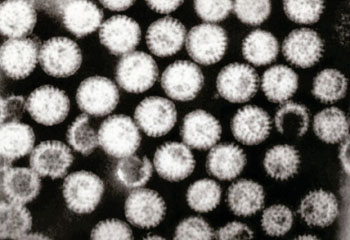Activating the Innate Immune System Cures Rotavirus Infection in Mouse Model
By LabMedica International staff writers
Posted on 25 Nov 2014
Stimulation of the innate immune system, either indirectly with bacterial flagellin or directly with interleukins IL-18 and IL-22, cured Rotavirus infection in a mouse model of the disease.Posted on 25 Nov 2014
Investigators at Georgia State University (Atlanta, USA) initially treated Rotavirus infected mice with flagellin, which binds to toll-like receptor 5 (TLR5).

Image: Transmission electron micrograph of multiple rotavirus particles in the feces of an infected child. Each one is about 70 nanometers in diameter (Photo courtesy of Wikimedia Commons).
Toll-like receptors (TLRs) are a class of proteins that play a key role in the innate immune system. They are single, membrane-spanning, noncatalytic receptors usually expressed in sentinel cells such as macrophages and dendritic cells, that recognize structurally conserved molecules derived from microbes. Once these microbes have breached physical barriers such as the skin or intestinal tract mucosa, they are recognized by TLRs, which activate immune cell responses. TLR5 recognizes flagellin, the protein monomer that makes up the filament of bacterial flagella, which is found on nearly all motile bacteria. There are highly conserved regions in the flagellin protein among all bacteria, facilitating the recognition of flagellin by a germ-line encoded receptor such as TLR5.
The investigators reported in the November 14, 2014, issue of the journal Science that administration of flagellin to Rotavirus-infected mice induced activation of TLR5 on the animals' dendritic cells, which elicited production of the cytokine interleukin-22 (IL-22). Then, IL-22 induced a protective gene expression program in intestinal epithelial cells. IL-22 is a member of a group of cytokines called the IL-10 superfamily, a class of potent mediators of cellular inflammatory responses. IL-22 is produced by activated DC and T cells and initiates innate immune responses against bacterial pathogens especially in epithelial cells such as respiratory and gut epithelial cells.
Flagellin also induced NOD-like receptor C4 (NLRC4)-dependent production of IL-18 in the infected animals. IL-18 is a cytokine that belongs to the IL-1 superfamily and is produced by macrophages and other cells. IL-18 works by binding to the interleukin-18 receptor, and together with IL-12 it induces cell-mediated immunity following infection with microbial products like lipopolysaccharide (LPS). After stimulation with IL-18, natural killer (NK) cells and certain T-cells release interferon-gamma (IFN-gamma) or type II interferon that plays an important role in activating the macrophages or other cells. In the current study, administration of IL-18 led to immediate elimination of Rotavirus-infected cells.
"What we have done is to broadly activate the innate immune system in a manner that will likely impede a wide range of viruses,” said senior author Dr. Andrew Gewirtz, professor of biology at Georgia State University. “We have described a completely novel way to combat a viral infection by use of a bacterial-derived activator of the immune system. It is analogous to equipping an NFL defense with baseball bats. Blatant violation of all the rules but yet, at least in this case, very effective."
Related Links:
Georgia State University













